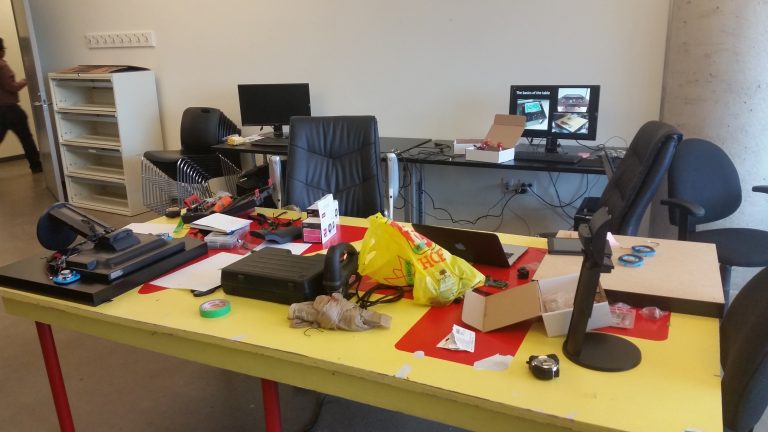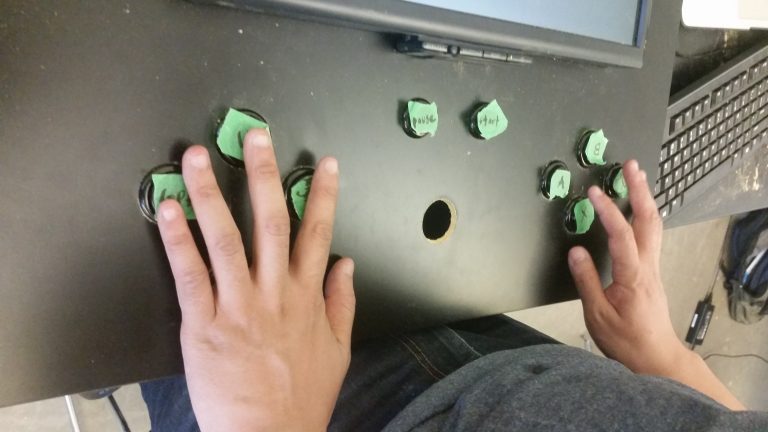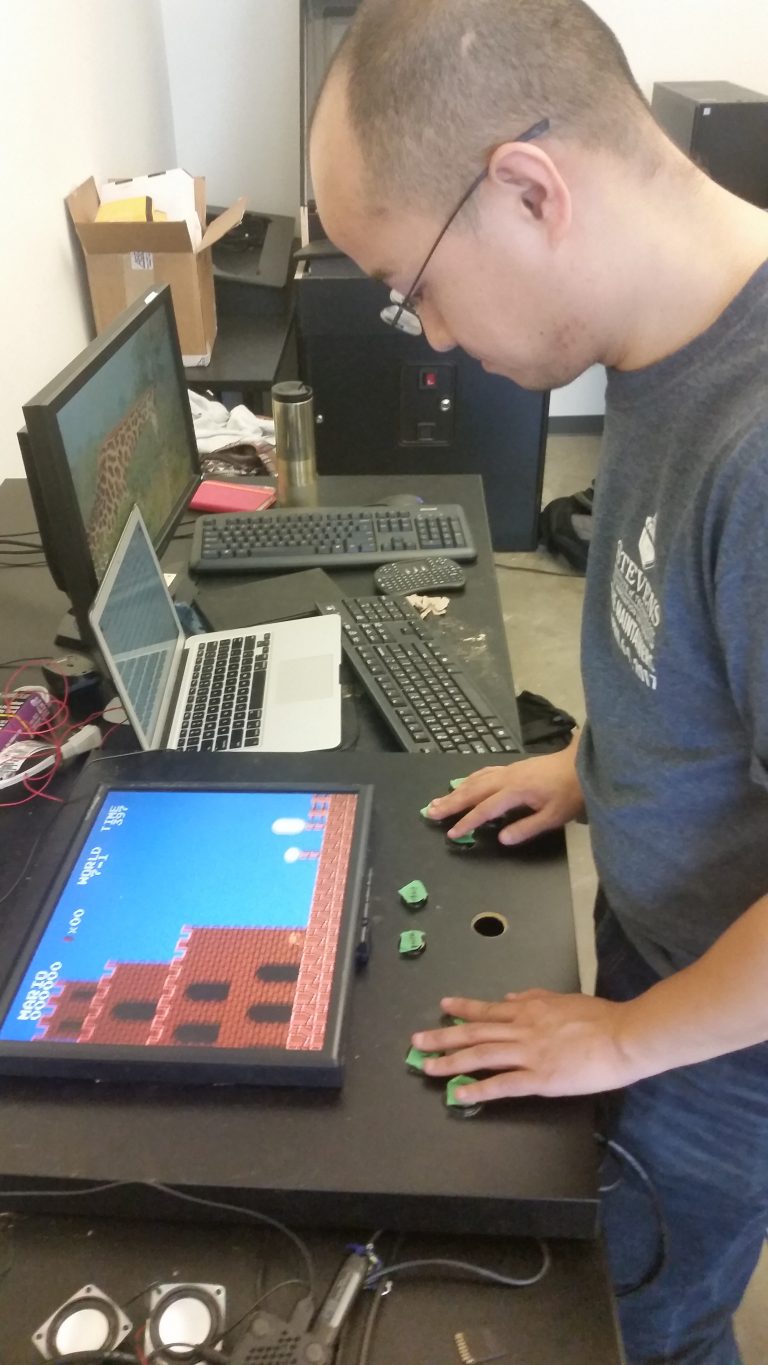Reflections on the experience of building an arcade table

The worktable in the Milieux Institute at Concordia
During my week at the Residual Media Depot, I participated in a group of two teams, with 2-3 members each, and transformed an IKEA coffee table into an arcade table using after-market arcade parts and a raspberry pi emulator. In this post, I discuss some of the ideas that emerged from the experience.
Design is a collaborative process informed by phenomenology of play:
One’s experience of play adapts and iterates over time. One’s experience of play is linked to one’s experience of control; one’s concept of play is informed by one’s conception of controller. Differences in these conceptualizations manifest when designers draw on their experiences to redesign or remake a familiar concept. In my group, for example, each of us seemed to approach the table with distinct but undisclosed conceptualizations of play, playfulness, control and controller.

Bo lays hands upon the controller
One of the predominant area in which these factors disclosed themselves to us was in the theorization of controller design; namely, we each approached the concept differently. While I can’t speak for the experiences of others on the team, my conception of controller was informed by my experiences as a child suffering through the uncomfortable controllers. Research suggests I was not alone in this experience. In a systematic literature review, Dr. Jalink et al. (2014) found 38 articles published before June 2014 that studied Nintendo related injuries (“30 case reports, seven case series, and one prospective study”). The reported injuries ranged from the neurological (reports of seizures and even “persistent auditory hallucinations”) to the physical and even the psychological. Studies reported on developments of Nintendo-related incontinences, for instance, including “faecal soiling” and “daytime enuresis”. As Jalink et al. describe the situation, “all children were so engrossed in Super Mario Bros that they ignored their urge to go to the toilet”. The most commonly reported injuries, and the ones most germane to a discussion of controller design, were the repetitive stress injuries associated with prolonged play sessions, which varied between controller types. In other words, the design of each controller led to distinct physical injury types. “After the introduction of the Nintendo 64 console in 1997, reports of the original nintendinitis subsided. But with a new controller, new problems arose.” Namely, “central palmar ulcer” (or “ulcerative nintendinitis”), an ulcer that developed on the thumb, particularly from games like Mario Party, when “players discovered that it was quicker to rub the joystick with their palm” than their thumb to win the game.
The masochism of play is thus, in some ways, controller-specific. Or rather, that the aesthetics and phenomenology of pain are unique to each player. (Indeed, by the time the Wii’s motion controls are introduced, reported injuries escalate to lacerating and even musculoskeletal traumas). In regard to my own recollections of the painful play, I belonged to that liminal generation brought up in a household with both SNES and N64 controls, and thus still nostalgically recall the trauma of both “tendinitis of the extensor pollicis longus” (affectionately dubbed nintendonitis by my brother, a term he probably acquired from friends) and persistent “ulcerative nintendinitis”. In other words, I rubbed and groped my hands raw through persistent play on both consoles. I sought to mediate that trauma in the redesign. Wounded by play, I sought to repeat the trauma in the controller. I wonder what psychology might make of my potentially sado-masochistic urge to do so. Alex and Bo, meanwhile, both sought to make controllers that would maximize play potentialities for all users (Alex, for instance, was keen to make a table that her father could also have fun using).
Thinking through making, or rather, the act of making to provoke thinking, has emerged as a key topic in digital humanities pedagogy. Boer, Donovan, and Burr refer to this process as provotyping, “provocative prototyping”.
The Stratos Innovation Group offers an extended definition of provotype:
Provotypes are designed artifacts that are informed and inspired by emerging technologies, user interviews, and co-creative engagement with end-users and organizational stakeholders. They can be used as a quick and effective means to explore a problem/solution space by providing tangible ideas to spark discussions. Here the goal is not to evaluate the artifact but to pick it apart, manipulate it and explore new directions. In doing so, the artifact ignites discussions around deeper unmet needs or ideas for possible futures.
(“Moving from Prototyping to Provotyping”)
While provotypes are helpful in thinking about future design, I think they can also provoke reflection on past designs and ask designers to think through embodied experiences. Provotyping reveals the tensions inherent in design; it “stir[s] dialectical processes of reflection on how conceptions currently are, and fuel[s] the front end of a development process by speculating how conceptions could be different” (Boer, Donovan & Burr).
The process of designing a controller can serve as the impetus for a diachronic examination of controller design (across both time and platforms), a discussion that could consider the logic of both controller design and their relationship to gaming hardware and technology. The gestalt of controller proceeds from the initial encounter of unwrapping from the box (which I imagine is more often than not discarded by the player), and develops from the accretion of subsequent experience in both social and individual play sessions. Designing and building controllers can thus serve as an interesting space for thinking through feedback loops. In the case of the analogue stick, the emergence of 3D graphical chips allowed for game designers to expand the range of movement in a ludic space, presumably required a concomittant evolution in input, which required a re-design of the controller accordingly. But I would be interested to learn more about the sequence of design decisions of both hardware and software involved in these remakings and remappings (at the very least, I think it would make a great project for a class to undertake). It’s interesting that these considerations emerged out of the embodied process of going through these ontological motions myself, by retrofitting an emulator into a table, refitting a table into a controller to produce a hybrid console.

Playing an emulated Mario game on the table
The emulator itself is another provotype, but one which remained blackboxed for me and so I have little to theorize about it. Nevertheless, Galey and Ruecker (2010) argue for the relevance of digital provotypes to the making of meaning, declaring that “digital artifacts themselves—not just their surrogate project reports—should stand as peer-reviewable forms of research, worthy of professional credit and contestable as forms of argument” (407). Objects, whether digital or not, have implicit arguments to offer, and, more importantly, “[t]he digital humanities must not lose sight of the design of artifacts as a critical act, one that may reflect insights into materials and advance an argument about an artifact’s role in the world” (407). There is much to be made of the process of emulation, and the presence of an emulator in the nostalgic restaging of one’s primal site of play (for example, all members intuitively emulated the NES console as a-matter-of-course, despite no explicit instruction to do so.)
Questions related to pedagogy that emerged from the arcade project:
- What could be the desired outcome of such a project?
- What documentation, instruction, guidance would the learner require to meet these outcomes? What instruction or supporting documents should the learner not receive to avoid foreclosing design and building ideas?
- How might the familiarity with terminology be relevant or helpful to the process? To what extent is it necessary for learners to think through concepts like hardware, software, platform, console, controller? To what extent is it helpful for learners to be aware of game and media studies?
- At what point could these materials be given, or these conversations be considered?
- To what extent should the language of the instructions be considered? For instance, to what extent might the term “re-design” presuppose a degree of familiarity with the past design? Or a concept like re-make (moreover, to what extent does the learner need to know how the original was made or should be made?). Such prefixes might direct the design and fabrication process towards certain disciplinary frameworks which may or may not be understood by the learner.
- More broadly, to what extent is the production of the new relevant to the study of the old and vice-versa? (This cuts to the heart of the media archaeology paradigm itself)
- To what extent is the history of game controllers, game consoles and game design important to the question of re-design or re-making (or, dropping the pre-fixes: designing or making)? Or, flipping the focus, do learners need to re-design and re-build a controller to think through the past of controllers?
- Alex’s presentation confronted this last set of questions. One slide in particular traced the progression of Nintendo platforms across time, noting the junctures at which Nintendo sought to mediate its own consoles in the hardware. In what ways is the Super Nintendo outfitted with the Gameboy adapter cartridge like the Gameboy system the pair seek to mediate? In what ways is this hybrid different from the Gameboy emulator released on the Virtual Console for the Nintendo DS and 3DS? Or the Wii? Is there a genealogy of design to consider? In what way, for that matter, is the Gameboy as a console like the tables we built? These tables bear the unmistakable stamp of their diverse and disparate origins despite their plurality. I imagine playing through these platforms, both emulated and original, might offer a site for thinking through such questions of hardware and software in the experience of play. Thus, the workshop impelled broader questions of how to incorporate these diverse cultural, historical and perspectival considerations of controller and console design. I imagine my perspective of controller and console will be influenced by this experience of trying to manufacture an arcade table.
Reflections:
- Building an arcade table challenged my assumptions of the design process.
- The brevity of the project (lasting just 3 afternoons) left little time to theorize. I’m used to dealing on timespans of weeks and months, not hours and minutes. This accelerated process offered little time to dwell in the realm of theoretical interpretation. This restriction can be quite liberating, particularly in my case, since I often have the tendency to get stuck at the level of interpretation.
- Building an arcade table challenged my perception that the outcome of a workshop was to deliver a final product.
- It was strange to find myself repeating patterns of educational behavior that had been ingrained into me through a decade of higher level academia. That nagging question: but what will get me the best grade? What clever twist can I bring to the table (literally, in this case) that sets it apart. How can I approximate the platonic ideal of [arcade] table that I anticipate the instructor must possess? On multiple occasions throughout our design process our group stopped and asked each other “but what exactly are we trying to do here?” The more I found myself repeating this question the more I began to think of it as metonymic of the methods by which I seek to produce knowledge. Again, this theorization of product can be helpful to a point, but in some ways it can actually stymie production (indeed, our group began construction much later than the other group, and to my knowledge did not manage to assemble the table in time).
- The instructions had been carefully presented so as not to foreclose possibilities. “This is an object we can build. Here are all the materials. What would you like to do?”. In student mode (and not learner mode) I tried to anticipate what the instructors wanted, or rather, that idealized instructor, the platonic instructor accreted in my imagination over a lifetime of academia, part Socratic daemon, part unappeasable shoulder gremlin: encouraging, prodding, debating, nurturing, second-guessing and over-ruling.
- Any intervention on the part of the instructors was taken as a signal of intent, whether intended to be or not. I’m over-reliant on interpretation and find it can be difficult to switch off. At one point, after hours of our group theorizing and having yet to touch the pieces, it was suggested that we should be thinking about moving toward how we’re going to start building the board. Implicitly I amplified this suggestion to our goals: aha, I thought, so we are meant to finish this thing.
- And yet, perhaps paradoxically, there was nonetheless an outcome, and I spent most of my time trying to detect and anticipate.
- I think the point is that I need to get my mentality out of this totalizing trap to take everything to the ultimate end, this all or nothing, win-or-lose dichotomy.
References
Galey, Alan, and Stan Ruecker. 2010. “How a Prototype Argues.” Literary and Linguistic Computing 25 (4). Oxford University Press: 405–24.
Jalink, Maarten B., Erik Heineman, Jean-Pierre E. N. Pierie, and Henk O. ten Cate Hoedemaker. 2014. “Nintendo Related Injuries and Other Problems: Review.” BMJ 349 (December): g7267.
“Moving From Prototyping To ‘Provotyping’ – Stratos Innovation Group”. Medium. N. p., 2016. Web.